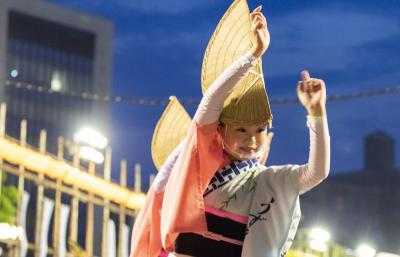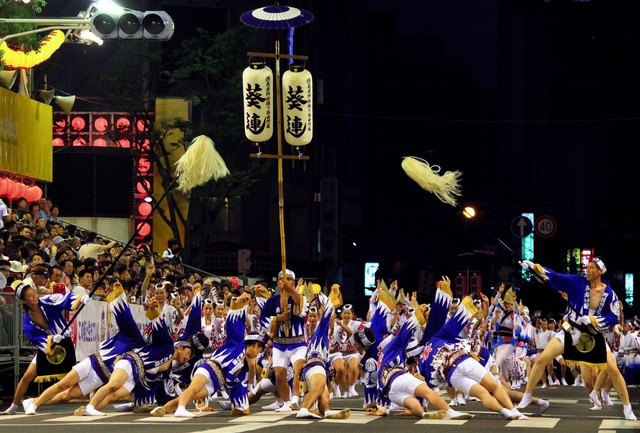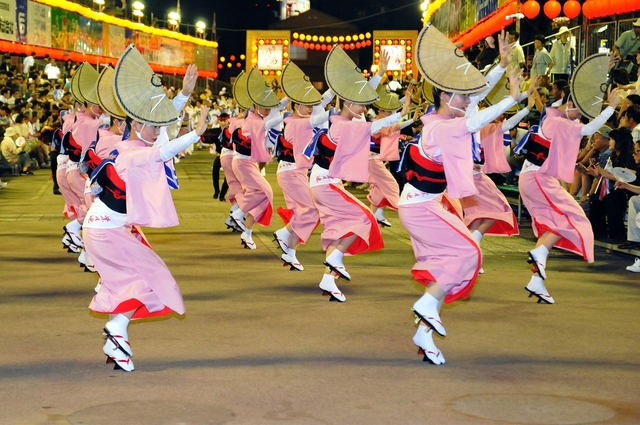文字サイズ
Tokushima Prefecture
The world famous Awa Dance has a 400 years’ history. The story of its origin varies.
It is said that Awa Dance was performed often around the time Hachisuka Iemasa, a feudal load of Tokushima, entered Tokushima in 1586, and hoarded the wealth produced by the indigo and salt trades. Later, indigo traders played an active part and made the dance even more gorgeous year by year.
Awa Dance was established in the civil society and flourished as a free-form of mass entertainment. Especially, after World War II, it developed rapidly as a symbol of reconstruction.
Nowadays, Awa Dance is well-known around the world as a representative of Japan’s traditional arts.
Currently, the “Naruto City Awa Odori” takes place on August 9 every year as the first Awa Dance festival and other Awa Dance festivals are held later in various places in Tokushima Prefecture. The busiest and most popular one is the Awa Dance festival in Tokushima City which takes place between August 12 and 15 every year.

There are three theories as to the origins of the Awa Dance
This theory states that the dance originates from a celebration by local people, performed after the construction of Tokushima Castle, ordered by Hachisuka Iemasa, was completed in 1587.
Kumiodori (the Awa Odori’s peculiar trait of being performed by multiple different groups) is said to have been influenced by the Furyu dance, said itself to be the origin of Noh plays. The Miyoshiki record written in 1663 shows that Sogo Nagayasu (also pronounced Masayasu) held a Furyu dance at Shozui Castle in 1578, and this is believed to be the start of the Awa Dance.
The Awa Odori is held in the 7th month of the ancient Japanese lunisolar calendar, at the same time as the Bon Dance. The Bon Dance is said to have led to the unique Niwaka and Kumiodori dances.
To allow visitors to gain a greater appreciation and enjoyment of the dance, we have collected some commonly used terms and their meanings below.
Please take a look at these unfamiliar terms.
One of the individual groups of dancers in the Awa Dance.
These groups include both the famous and long-standing Yumeiren, as well as a diversity of other “rens” consisting of company employees and students etc. In total there are more than 1,000 rens in the dance.
The Awa Dance’s cheerful duple time rhythm is known as “zomeki”. It also means “boisterous”, and implies a dance that is both showy and lively.
The song that is sung during the Awa Dance. Although the origin is not clear, it is said to have been a popular late-Edo Period folk song and the indigo merchants brought the song to Awa from Kyoto and Osaka.
It means the correct traditional tune of singing.
Normally it implies a musical scale; however, in the case of Awa Dance, it means traditional and authentic in a broad sense.
A parade formed by only musical instruments such as shamisen (a three-stringed musical instrument similar to a guitar) from morning until noon, going through the town. It is the standard to perform only the sound without a dance.
At the start of the dance and throughout, a dancer will yell out “Yattosa!” with the others replying “Ah, yatto, yatto!” (It means “It’s been a while, how are you?”).
Musical instruments playing the role of the background music of the Awa Dance including Shamisen, O-daiko (big drum), Shime-daiko (small high-pitched drum), Kane (gong), Fue (flute) and Tuzumi (hand drum).
At the front of every “ren” are two paper lanterns with the name of each ren held on a long bamboo pole. This has the role of regulating the forward speed of the dancers, but is often blown about by the wind, and so requires a lot of strength to hold.

The braided hats (kasa) that female dancers wear used to be a variety of shapes, but the Torioigasa is currently popular. Torioigasa literally means “bird scaring hat” (in rice paddies and fields) and were originally designed to completely hide the wearer’s face, while scaring birds from the fields. Pulling the hat down over one’s eyes while only partially hiding one’s face gives wearers a refined and bewitching look, enhancing the nape of their neck.

Copyright © Tokushima Prefecture, All rights reserved.